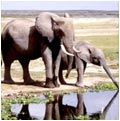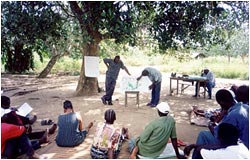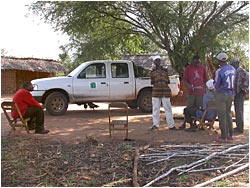|
CONSERVATION IN THE COASTAL FORESTS
 Given the known biological values of and the increasing threats to the coastal forests, time is of the essence for conservation measures. The recognition and designation as a hotspot, with significant investment from the Critical Ecosystem Partnership Fund, has already raised the profile of the Coastal Forests and the understanding of conservation, institutional and community needs. WWF have formulated an ecoregion conservation strategy for 2005-2025, with inputs from many key stakeholders. The strategy will provide an overarching framework on how to achieve a biodiversity vision through short, medium and long term goals. It also brings together stakeholders to develop strategies and potential activities aimed at long term collaboration and effective participation of individuals and organizations. Ecoregion conservation is not separate from ongoing site-based and related activities, but provides a broader framework for more localised conservation initiatives. Given the known biological values of and the increasing threats to the coastal forests, time is of the essence for conservation measures. The recognition and designation as a hotspot, with significant investment from the Critical Ecosystem Partnership Fund, has already raised the profile of the Coastal Forests and the understanding of conservation, institutional and community needs. WWF have formulated an ecoregion conservation strategy for 2005-2025, with inputs from many key stakeholders. The strategy will provide an overarching framework on how to achieve a biodiversity vision through short, medium and long term goals. It also brings together stakeholders to develop strategies and potential activities aimed at long term collaboration and effective participation of individuals and organizations. Ecoregion conservation is not separate from ongoing site-based and related activities, but provides a broader framework for more localised conservation initiatives.
Landscape approaches to conservation to enhance connectivity of fragmented coastal forest patches is one type of initiative that is being used by various NGOs in the hotspots, such as in the lowland Usambaras by WWF-Tanzania and TFCG and in the Gendagenda-Msumbugwe-Sadaani area.  Other initiatives have focused on strengthening the capacity of governments and districts and empowering communities (TFCG and WWF). Yet others are focused on collecting baseline information on specific target areas or species (Mpingo Conservation Project). In both Kenya and Tanzania there is a general move towards using various forms of Participatory Forest Management for forest conservation. The idea is that by giving the community some user rights and management responsibility towards the forest, thereby instilling a sense ownership, levels of protection will be greater than when adjacent communities are denied any user rights at all. Projects in Tanzania are exploring this approach and significant funding has been provided by the governments of Denmark and Finland, and the World Bank. Other initiatives have focused on strengthening the capacity of governments and districts and empowering communities (TFCG and WWF). Yet others are focused on collecting baseline information on specific target areas or species (Mpingo Conservation Project). In both Kenya and Tanzania there is a general move towards using various forms of Participatory Forest Management for forest conservation. The idea is that by giving the community some user rights and management responsibility towards the forest, thereby instilling a sense ownership, levels of protection will be greater than when adjacent communities are denied any user rights at all. Projects in Tanzania are exploring this approach and significant funding has been provided by the governments of Denmark and Finland, and the World Bank.
In Kenya, BirdLife International (through their local partner, Nature Kenya) has been involved with conservation of the Arabuko-Sokoke forest for over 10 years, and WWF has also provided assistance to the conservation of the kaya forests for the same  length of time. In Tanzania, the Tanzania Forest Conservation Group, WWF-Tanzania Programme Office and the Wildlife Conservation Society of Tanzania have also been working with the government to conserve important coastal forest patches for more than a decade, joined more recently by CARE-Tanzania and the IUCN forest program. Significant funding for coastal forest conservation has been made available by the Finnish International Development Agency (Global Finland) in the East Usambaras and Mtwara Region, by DANIDA in Kilwa and Lindi Districts of Lindi Region, and by the Global Environmental Facility (GEF) in Jozani on Zanzibar. Further south in Mozambique, WWF has assisted the Mozambiquean government to develop the new Quirimbas National Park. These inputs have been crucial to help secure the future of the coastal forests of Kenya and Tanzania. length of time. In Tanzania, the Tanzania Forest Conservation Group, WWF-Tanzania Programme Office and the Wildlife Conservation Society of Tanzania have also been working with the government to conserve important coastal forest patches for more than a decade, joined more recently by CARE-Tanzania and the IUCN forest program. Significant funding for coastal forest conservation has been made available by the Finnish International Development Agency (Global Finland) in the East Usambaras and Mtwara Region, by DANIDA in Kilwa and Lindi Districts of Lindi Region, and by the Global Environmental Facility (GEF) in Jozani on Zanzibar. Further south in Mozambique, WWF has assisted the Mozambiquean government to develop the new Quirimbas National Park. These inputs have been crucial to help secure the future of the coastal forests of Kenya and Tanzania.
Some of the projects active in the Coastal Forests in Kenya and Tanzania are given in more detail below - with links to their websites.
Arabuko-Sokoke Forest Management and Conservation Project, Kenya
The Arabuko-Sokoke Forest Management and Conservation Project is jointly managed by the Kenya Wildlife Service, Kenya Forestry Research Institute and National Museum of Kenya, with support from the European Union and BirdLife International. It was started in 1991 and grew from the realisation that there was a need to involve communities and other stakeholders in forest management, and to catalyse policy changes in the forestry sector in the country. The aim of the project is to enhance conservation of Arabuko-Sokoke’s biodiversity and ecological functions, as well as the socio-economic and cultural values. The broad components of the project are: natural forest management and conservation; rural development; visitor and conservation education and training, monitoring and evaluation.
A Strategic Forest Management Plan (2002-2027) has been developed jointly and is a first step towards harmonising the interests of the various stakeholders concerned with the conservation of Arabuko-Sokoke Forest.
Bamburi Cement Ltd, Kenya
Bamburi Cement Ltd has been conducting quarry rehabilitation projects for 35 years and aims to recreate vanished Coastal Forests and Wetlands. It has already planted 400 indigenous tree species in Kenya and an example of successful rehabilitation can be seen at Haller Park, a popular recreation site for tourists and locals.
The company is also involved in other conservation efforts, working with WWF in the Shimba Hills Forest in a landscape restoration project that aims to protect the original forest, which is one of the main seed sources for indigenous trees used by Bamburi in their quarry rehabilitation schemes. The link with WWF is long standing and the parent company, Lafarge, and WWF signed a worldwide partnership agreement in Paris in the framework of WWF's "Conservation Partner" Programme, with objectives for improving its environmental policy, developing WWF's project "Forests Reborn" and raising awareness of the importance of preserving biodiversity.
Critical Ecosystem Partnership Fund (CEPF)
The Critical Ecosystem Partnership Fund enables conservation action and builds capacity for sustainability in biodiversity hotspots, the Earth’s biologically richest and most endangered regions. It is a joint initiative of Conservation International (CI), the Global Environment Facility (GEF), the Government of Japan, the MacArthur Foundation and the World Bank. In 2004, CEPF began a US$7 million investment strategy to fund projects in the Eastern Arc Mountains and Coastal Forests region.
A fundamental goal of CEPF is to ensure that civil society is engaged in efforts to conserve biodiversity in the hotspots. Where appropriate, CEPF aims to complement existing strategies and frameworks established by local, regional and national governments. It targets transboundary cooperation when areas rich in biological value straddle national borders, or in areas where a regional approach will be more effective than a national approach.
Kipepeo Project, Kenya
The Kipepeo Project (‘kipepeo’ means butterfly in Swahili) is a forest butterfly farming initiative started in 1993. It is based at Gede Ruins National Monument, close to Arabuko-Sokoke Forest and is currently supported by BirdLife International through the EU-funded Arabuko-Sokoke Forest Management and Conservation Programme and administered by the East African Natural History Society in partnership with the National Museums of Kenya. It aims to provide an alternative income to farmers who raise butterfly pupae which are sold for export. This initiative not only provides an alternative income to 690 farmers but it gives a value to the natural forest rather than clearing it for farmland and is a popular tourist attraction.
Mpingo Conservation Project, Southern Tanzania
The non-governmental organisation (NGO) Mpingo Conservation Project was founded in 1995 (originally named the Cambridge Mpingo Project) to investigate the ecology and exploitation of the very valuable hardwood timber Dalbergia melanoxylon (named Mpingo in kiswahili) in Southern Tanzania. This timber is found in East African Coastal Forest and Miombo woodland and is used for carvings, musical instruments, building, tools, medicines and other local uses. It is vulnerable to local and commercial extinction given current harvesting rates.
The Mpingo Conservation Project primarily works in Kilwa District, Lindi region, Southern Tanzania, although previous research has been conducted throughout the region. The project aims to use mpingo as an economic tool to advance habitat conservation through the promotion of sustainable and socially equitable exploitation of natural resources.
The project has various partner organisations in Tanzania (Wildlife Conservation Society of Tanzania and University of Dar es Salaam) and internationally (Fauna and Flora International and Environment Africa Trust).
Nature Kenya, Kenya
Nature Kenya was founded in 1909 with the mission of ‘connecting nature and people’. It is a partner of BirdLife and has strong collaborative links with the National Museum of Kenya, Forest Department and Kenya Wildlife Services. Some of its key activities include: IBA conservation and monitoring, nest recording schemes, education and training and input into specific projects, such as the Arabuko-Sokoke Forest Management and Conservation Programme. One of its recent ongoing projects is to maintain and expand the biodiversity database for the Eastern Arc Mountains and Coastal Forest Hotspot.
Rufiji Environment Management Programme (REMP), Southern Tanzania
The Rufiji Environment Management Programme was developed by IUCN with the Rufiji District in response to requests for assistance. The project goal was:
"To promote the long-term conservation through ‘wise use’ of the lower Rufiji forests, woodlands and wetlands, such that biodiversity is conserved, critical ecological functions are maintained, renewable natural resources are used sustainably and the livelihoods of the area’s inhabitants are secured and enhanced."
The first five year phase (1998-2003) has been completed and goals achieved with the establishment of an Environmental Management Team at District level, Environmental Management Plans and Wise Use Activities. The project continues under the IUCN Forest Program.
REMP was supported by the Royal Netherlands Embassy in Tanzania. Project partners are NEMC, the Coast Region, RUBADA, The Royal Netherlands Embassy and the Ministry of Natural Resources and Tourism.
Tanzania Forest Conservation Group (TFCG), Tanzania
The Tanzania Forest Conservation Group is a non-governmental organisation founded in 1985 to promote the conservation of forests with high biodiversity in Tanzania, in particular the Eastern Arc Mountains and Coastal Forests. TFCG has worked to provide sustainable solutions to the problems that have driven deforestation in this unique area. It has five general programmes: Participatory Forest Management, Research, Environmental Education, Community Development, and Advocacy. Three projects focus on sustainable conservation of Coastal Forests: Ngaramia Riverine Conservation Project; Misitu Yetu Projects in Pande Game Reserve and Ruvu South Forest Reserve.
TFCG is the national link for CEPF in Tanzania. www.cepf.tfcg.org
Within coastal forests TFCG collaborates with other NGOs in Tanzania, such as WWF, Wildlife Conservation Society of Tanzania and Care International. TFCG is principally supported by the African Rainforest Conservancy.
TFCG produces the biannual Arc Journal which is available online.
Wildlife Conservation Society of Tanzania (WCST), Tanzania
The Wildlife Conservation Society of Tanzania (WCST) was founded in 1988 and has the mission of ‘conserving the fauna and flora of Tanzania for the sake of mankind’. They are a partner of BirdLife and key activities include: protection and conservation of forests, animal and plant species with specific focus on birds and their habitats; environmental education and awareness; advocacy and research. They have carried out coastal forest conservation projects in the Lindi, Coast and Tanga Regions since 1990, with 23 schools establishing nurseries and planting more than 2 million tree seedlings. WCST are members of the Coordination Unit for CEPF in the hotspot.
World Wide Fund for Nature - East Africa Coastal Forest Ecoregion Programme (WWF-EACFE), Kenya and Tanzania
The World Wide Fund for Nature has been working in the East Africa Coastal Forests (EACF) since early 1991. Its objectives are:
"To conserve the biodiversity of the Eastern African Coastal Forests while ensuring sustainable use of the forest resources in harmony with the needs and aspirations of East African people."
The aim of the East Africa Coastal Forest Ecoregion Programme is to: a) scale up activities of the coastal forest projects into a programme; b) improve the coherence and synergy between stakeholders’ activities in order to address the needs of target groups in the region; c) improve linkages between field activities and policy implementation; and d) increase capacity building potential and opportunity for efficiency of scale and lessons learned, shared and applied.
A strategic framework for conservation has been developed by WWF-EACFE for 2005-2025. This was produced together with a wide range of stakeholders to establish a clear set of priorities, operating principles and strategies to achieve the goals of conservation, management and sustainable use of forests in the region.
WWF has also supported smaller national projects, such as the Kaya Forest Project, Kenya, in collaboration with the National Museum of Kenya; the Lowland Coastal Forest Project, Tanzania, which has focal forest project sites; and, Bazzaruto National Park, Mozambique. Such projects include working with village, District and forest departments to increase institutional capacity to manage the natural resources; facilitate participatory management of natural resources; increase awareness on conservation and sustainable resource use; develop an alternative resource base; and conduct biological and socio-economic surveys for monitoring management of coastal forests.
|



